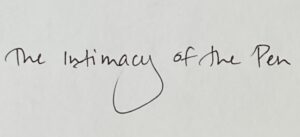 I missed a big chunk of first grade because I was laid up with tuberculosis. As a result, by the time I hit second grade I could barely write my name. Everyone else in the class, I noticed, published themselves every chance they got. In blocky letters they scrawled their names across the blackboard, chalked them on the benches in the playground and on the seats of the swings. They bore down heavily with their pencils until they tore holes in their paper, so ferocious was their desire to call attention to their existence, to show off a name that meant them.
I missed a big chunk of first grade because I was laid up with tuberculosis. As a result, by the time I hit second grade I could barely write my name. Everyone else in the class, I noticed, published themselves every chance they got. In blocky letters they scrawled their names across the blackboard, chalked them on the benches in the playground and on the seats of the swings. They bore down heavily with their pencils until they tore holes in their paper, so ferocious was their desire to call attention to their existence, to show off a name that meant them.
When cursive writing came about in third grade, I had joined the ranks of the overly-eager. I too was tearing holes in my paper with an urgency to express myself. Perhaps because writing came to me almost a year later than it did to my peers, I couldn’t help but appreciate the enormity of writing’s task. I didn’t think of it as the writer’s task to convince and convey, but the task of the handwriting itself. Each letter carried a responsibility to align itself correctly with its neighbors. Which is why cursive, or script as we called it, always made sense to me. The letters were connected to keep them from moving around, like a roped expedition up Everest, where each mountaineer is dependent on the integrity of every other, and a break in the line threatens the expedition’s success. Script was a step away from the joyful irresponsibility of childhood. It was solemn. It was beautiful. And to do it well was difficult. But to do it poorly was a mess and unacceptable. This was something, the first something in my life that required a commitment. I went from carefree to watchful, watchful to sober, and sober to dedicated, all in a matter of months.
Drew Gilpin Faust, a Civil War historian and the author of an article in The Atlantic, “Gen Z Never Learned To Read Cursive,” put forth the idea recently that our connection to our past has been weakened because cursive is no longer taught in school. So many of our primary sources are penned in cursive, like letters written from the battlefield, or ledgers marking the births and deaths of slaves, or a Georgia widow’s trepidation, written in a trembling hand as Sherman’s army approached. These human emotions, human connections, human accountabilities, are lost to those who cannot decipher them on the page. When the lessons of history are illegible, it’s impossible to learn from them. Literacy, always considered a prize in itself, the pathway to advancement and greater power, has fallen out of fashion. It has at least fallen out of the realm of possibility among those who were not taught to write, and therefore to read, cursive.
We forget that the act of writing by hand is, appropriately enough, manual labor. It begins in our fingers and moves through our neural pathways to enliven our brains. We consider it an art (or a burden), when in fact it’s a physical exercise that requires our muscles to flex, our gray matter to light up, and our hearts and lungs to run a marathon. The keyboards we’re all attached to have made our labor lighter, as so many of our tools are designed to do. Think chainsaw, snow blower, electric mixer, the Archimedes screw. But what is lost in the process? There’s been plenty of research on dishwashers as the cause of the break-up of the American family. Apparently, the end came when we no longer stood beside our mother and wiped the plates dry. But think of the mothers! Technology may have reduced our human interaction and our fine motor skills, but at the same time it’s provided us with more time to read. Or learn French. Or whack away on our keyboards. And if the constant whacking leads to carpal tunnel or arthritic thumbs, or the screens ruin our eyes, it’s nothing more than a reminder that writing is an act of the physical, as we are physical beings. And whether we express ourselves by mechanically tapping or through the warm flesh of our fingers curled around a pen, we are human bodies bound for obsolescence, yet second-graders still, proclaiming the fact of our existence.
Do we gain more than we lose when we don’t teach our children cursive? An argument has been made that we need cursive no more than we need to know how to churn butter. But here’s the thing, we can find butter in the dairy aisle of the grocery store, but we cannot introduce ourselves to the past through its abundant handwritten evidence unless we have been given the right tools. Unless we have a knowledge of cursive. “All of us,” writes Dr. Faust, “not just students and scholars, will be affected by cursive’s loss. The inability to read handwriting deprives society of direct access to its own past. We will become reliant on a small group of trained translators and experts to report what history—including the documents and papers of our own families—was about.”
As for my own past, I remember two things about the time I saw Robert Lansing in a delicatessen in Manhattan. The deli was small and we were its only customers. I remember he was buying a carton of potato salad, and I remember feeling so tongue-tied to be in the presence of Colonel Frank Savage, the rakish hero of my favorite TV show, 12 O’Clock High, I missed the opportunity to get his autograph. To hold in my hand a paper bag marked by the grease spots of my Reuben sandwich, and Robert Lansing’s autograph…. What a prize that would have been! When I think of that day I’m reminded that writing—handwriting—is more than its letters, whether they are cursively tied to one another or printed and marching alone across the page. Handwriting is a trail in the forest of obscurity. It is the evidence we exist and existed. It began with our names and moved out to encompass other things, other worlds. Handwriting’s task is to tell a story about the writer. Is she timid or bold? Does her hand shake with excitement or anger or age? Consider the intimacy. When I lay down a track of evidence with my pen, and you run your hand over the page, it is me you’re touching. I have been there where you are now.

